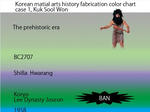To find out the pattern of Korean Uriginal martial art history, I translate them in Japanese.
国術院 ククスルウォンの歴史
http://www.kuksoolwon.com/site/history
Ancient History
The history of Korean martial arts is as old as the land itself and can be traced as far back as the prehistoric era, where primitive weapons made of wood and stone were used for hunting and fighting.
韓国の武術史は先史時代から始まる。石と木で作った原始武器を狩りや戦いに使っていたのだ。As early as 2707 BC, the Korean warlord Chi-Woo, also known as Jaoji, reigned as the “god of war” in what is now Mainland China.
紀元前2707年 コリアン武士の慈烏支桓雄が軍神として中国に君臨。
Since then, the majority of Koreans migrated and settled in the region of the Korean Peninsula, where there have been more than a thousand recorded instances of foreign invasions. Consequently, the Korean people developed unique martial arts and military strategies in order to defend themselves and their territory.
それ以来コリアンのほとんどは幾千もの戦いが記されている朝鮮半島に移住した。
故にコリアンは国を守るため武術や戦術を開発したのだ。Most of these Korean martial arts fall into three main groups or branches, namely tribal, Buddhist, and royal court martial arts.
コリアン武術の多くは3つの枝葉に分けられる、部族系、仏教系そして宮廷系だ。Tribal martial arts (SahDoh MuSool)
部族系武術(家族系ともいうらしい)The earliest martial arts developed in Korea are referred to as SahDoh MuSool; meaning tribal, clan, or family martial arts, as this type of martial art was mainly passed down from one generation to the next through family lines.
コリアン武術の初期はサドムスルと呼ばれ、部族や家族単位で何世代も受け継がれてきたものだ。SahDoh MuSool was popular among the ancient tribes, city-states and smaller kingdoms that formed in the Korean Peninsula and parts of what is now China.
サドムスルは中国や朝鮮半島の小さな国や町で、あるいは古代部族のあいだで人気があった。This was evident well before the first unified Korean kingdom of Ko-Cho Sun which was founded in 2333 BC by the legendary king, DahnGoon WahngGuhm.
これは紀元前2333年に檀君によって統一された古朝鮮王国以前であることがあきらかだ。Later, SahDoh MuSool was further developed and made widespread by voluntary militias comprised of the common people, who often fought in battles to defend their villages.
サドムスルは後に村を守るために戦った普通の人々によって進化し広まった。Traditional athletic activities such as Taekkyon, and Ssireum are considered to have originated from SahDoh MuSool. In fact, many techniques found in the popular Olympic sport of TaeKwonDo can also be traced back to SahDoh MuSool.
テッキョンやシルムはサドムスルが起源だ。オリンピックスポーツとして人気のテコンドーもだ。
Buddhist martial arts (BoolKyo MuSool)
仏教系武術Since Buddhism was first introduced to the kingdom of Koguryo in the year 347, a rather unique form of martial arts was developed by both Buddhist monks as well as martial artists, known as BoolKyo MuSool.
仏教は347年高句麗に伝来した。仏教武術は僧侶や武術家によって開発されていった。Buddhist monks originally developed and then practiced BoolKyo MuSool to improve their health while meditating and to defend themselves while traveling.
仏教武術は僧侶が旅行中に身を守るため、または健康のために武術を始めたのが始まりだ。As a result, Buddhist martial arts include both internal training, with emphasis on special breathing and meditation methods, as well as external training, with emphasis on extremely effective self-defense techniques.
結果として呼吸法や瞑想法などの内面的訓練が超すごい自己防衛術のような外面的訓練と共に取り入れられることになった。Many Buddhist monks were so accomplished as martial artists that they were occasionally called upon during national emergencies to fight in battles by forming unprecedented armies of warrior monks.
多くの僧侶は国家的危機に際し大規模な僧兵軍団を編成して参戦、武術家として大成した。To this day, BoolKyo MuSool plays a significant role for Korean martial artists by providing them with philosophies of non-violence and compassion as well as ethical codes of conduct, such as the famous Five Precepts of the HwaRang warriors.
こんにち、仏教武術は花郎の五戒のような思いやりと非暴力の哲学によりコリアン武術の重要な位置を占めるようになった。Royal court martial arts (KoongJoong MuSool)
宮廷武術Kings, royal families and government officials had private armies and bodyguards who practiced a type of martial art known as KoongJoong MuSool.
宮廷の人々は護衛のための私設兵団を持っていて、彼らが修練したのが宮廷武術だ。These royal court martial arts gave rise to esoteric techniques of easily portable weapons such as short swords and folding fans. Also developed were unique weaponless techniques of joint-locking and pressure point striking.
宮廷武術は短刀や扇のようなポータブル武器の秘技をもたらした。
または関節技や急所技なども開発した。Existing records in Japan suggest that many KoongJoong MuSool techniques found their way there and gave birth to the Japanese art of Jujitsu.
日本の史料によればこの宮廷武術が日本にわたり柔術になった。King JinHung of the Kingdom of Silla encouraged the HwaRang warriors to practice KoongJoong MuSool in addition to their other martial arts training.
新羅の真興王が花郎に彼ら自身の武術とともに宮廷武術の習得を推進した。But later during the Koryo Dynasty and Chosun Dynasty, Korean kings enforced policies to discourage the practice of martial arts and to forbid the possession of weapons, in order to protect themselves from military rebellion or any other political uprising.
しかし高麗時代と李氏朝鮮時代、国王は謀反を恐れて武術や武器の所持を禁じた。However, Korean martial arts have continued to develop both within and without the royal courts, thanks to the efforts of many dedicated Korean martial artists to practice, record, and compile these precious martial art techniques.
しかしありがたい事に有志の武術家によって宮廷の内外でこの貴重なコリアン武術の技術や記録は維持された。Traditional Korean martial arts (Kuk Sool)
伝統コリアン武術(国術)The three branches of traditional Korean martial arts: SahDoh MuSool, BoolKyo MuSool, and KoongJoong MuSool, were organized to form a single system known as Kuk Sool in 1958 by In-hyuk Suh, the founder and Grandmaster of Kuk Sool Won™.
それら3つの枝葉サダムスル、ブルキョムスル、クンジュンムスル、1958年に国術として統合された。
Kuk Sool has countless techniques derived from the three branches of traditional Korean martial arts and is structured to take a practitioner in a logical progression from the beginning all the way up to Master level.
国術の中の無数のテクニックはそれらコリアン伝統武術から取り入れられ、修練者をマスターレベルまで論理的に進歩させます。Kuk Sool Won™ has been actively promoted worldwide by the World Kuk Sool Association®, and it is also recognized in the martial arts community as one of the most effective and comprehensive systems of traditional Korean martial arts in existence today.
国術院は世界国術連盟によって世界中で愛好され、こんにち世界で最も効果的で総合的なコリアン伝統武術のひとつであると武術家に知られています。1.Origin-Caveman
2.Imaginary figures-Chi-Woo,DahnGoon
3.Imaginary martial arts-SahDoh MuSoo, BoolKyo MuSool, KoongJoong MuSool
4.Imaginary records-Existing records in Japan suggest that...the Japanese art of Jujitsu
5.Common noun as school's name-Kuksool means "national skill"

PR
http://ninjer.blog.shinobi.jp/uriginal%20issue/kuk%20sool%20won-%20s%20fabricated%20historyKuk Sool Won' s fabricated history

